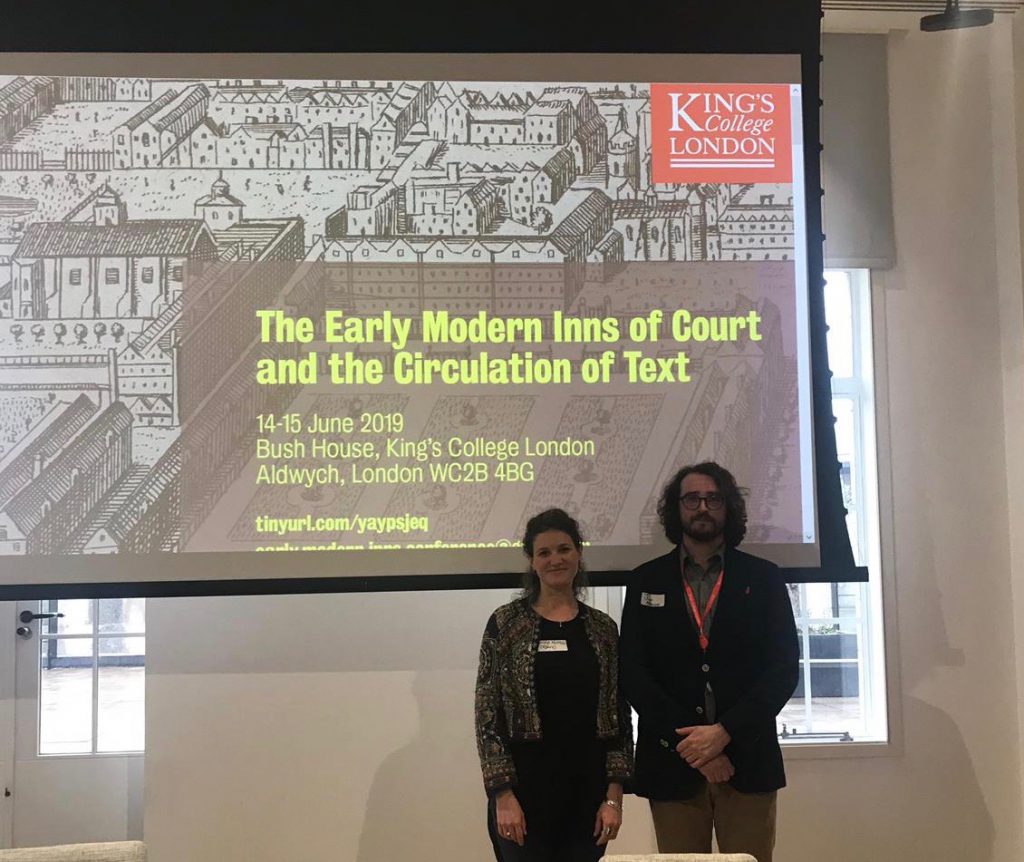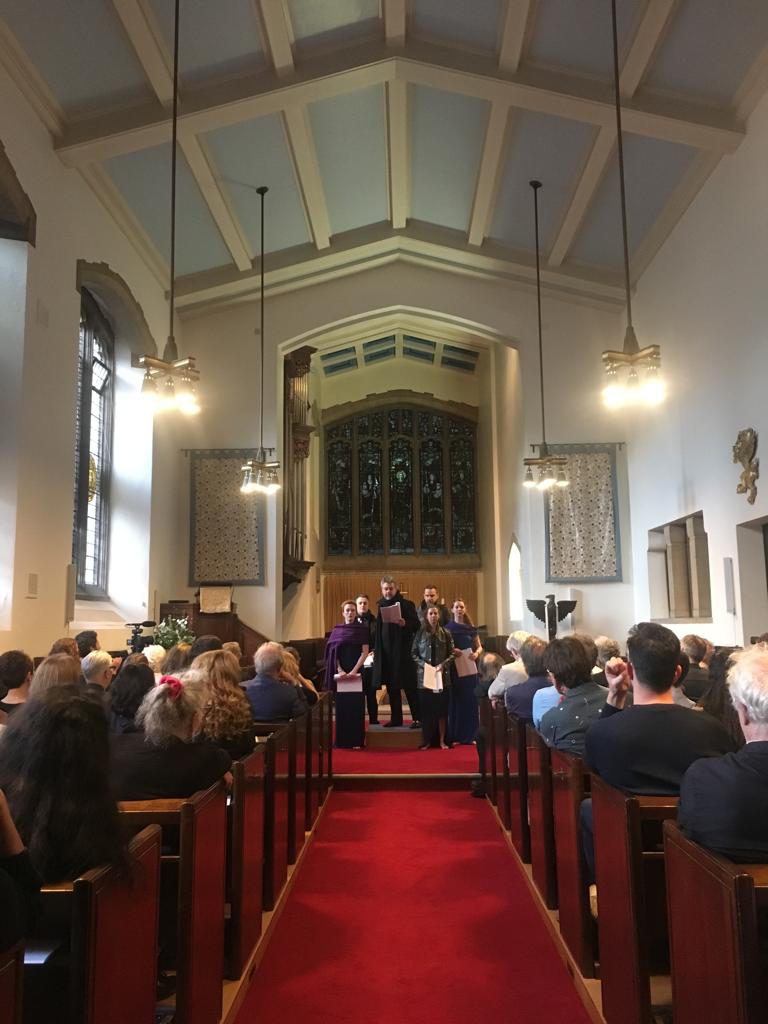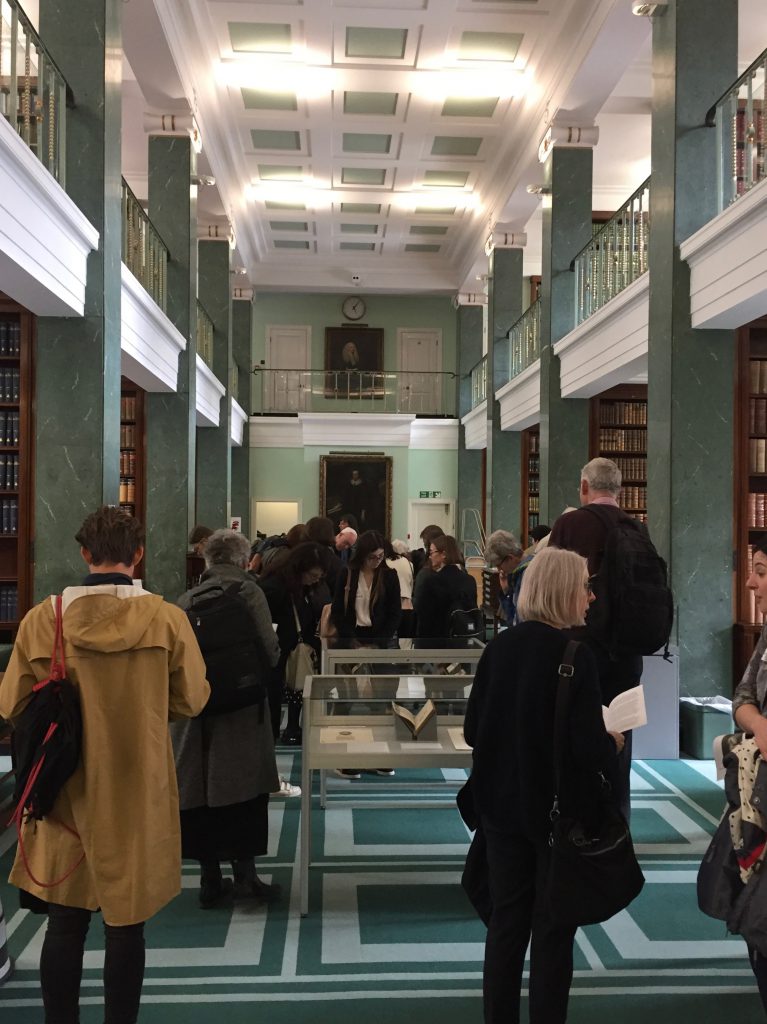By Dr Romola Nuttall and Julian Neuhauser
‘The Early Modern Inns of Court and the Circulation of Text’ was one of the events supported by the King’s English Department and two of its research groups (the Text Histories and Politics Research Cluster and the Collaborative Seed Fund Partnership) in the academic year 2018-19. This ambitious two-day conference took place in Bush House on 14-15 June 2019. What began as a conference expanded to include a talk at Middle Temple by the former Lord Chief Justice of England and Wales, (and Middle Templar) Lord Igor Judge, an event at Temple Church held in conjunction with the Inner Temple Historical Society and the Inner Temple Drama society, a Middle Temple Library exhibition of materials curated especially for the conference, and a professional revival of The Misfortunes of Arthur (1587) by the Dolphin’s Back theatre company in Gray’s Inn Chapel on 14 June 2019.
The conference and its accompanying events were organized by two researchers from English department, Dr. Romola Nuttall and Julian Neuhauser, who are co-authoring this blog post. This is the second part of a pair of blogs about this conference. The first of these posts describes the conference organizers’ reasons for putting the conference on. This post is intended to provide a report on the conference and a reflection on our time spent organizing the conference this year. We’d also like to use this space to reiterate thanks to our beneficent sponsors. Outside of the English Department and the research groups mentioned above, the conference was also supported generously by the Arts and Humanities Research Institute, the Centre for Early Modern Studies, and the London Shakespeare Centre at KCL and, outside King’s, we owe thanks to the Society for Renaissance Studies, the Inner Temple, and the Society for Theatre Research.

We began to organise the conference with the aim of highlighting the importance of the Inns of Court as centres of literary production. Both of us research the material and social aspects of early modern literature, and we wanted to create an event that furthered the exploration of how the literature created at the Inns impacted the social and political culture of early modern England. The conference confirmed some of our presumptions, giving the group the chance to dig deeper into our preexisting knowledge of Inns literature. But it also challenged our presumptions and exhibited the diversity of ways and reasons that Inns literature was produced and transmitted.
The talks offered by our plenary speakers exemplified this expansion of perspective. The opening plenary, by Professor Michelle O’Callaghan (University of Reading), broadened the humanist, self-governing ideal of the enclosed environment of the Inns by exploring letters that record female presence at the Inns, a miscellany of nonsense verse attributed to Middle Templar John Hoskins and Lady Mary Jacob and accounts for monies paid by the Inns to laundry women. In our closing plenary, Professor Arthur Marotti (Wayne State University) shared details of manuscript collections kept by law students that include unique sets of poems, accounts of sobering deaths and records of dancing in revels. These collections trace courtly and provincial connections between the Inns and their members and reveal a non-systematic approach to textual collection which reflects the heterogeneous interests and pursuits of these communities.
The panels generated a similar sense of the diversity of texts read and disseminated by students and lawyers at the Inns. For example, Penelope Geng (Macalester College) discussed Gray’s Inn member Francis Bacon’s distinctively poetic 1625 translation of the Psalms as an act of “professional piety”, Joshua Eckhardt (Virginia Commonwealth University) explored records of books owned by Innsmen and where they bought them from, while Jennifer Young (University of Greenwich) used the variant texts of Shakespeare’s Othello to demonstrate marketing and editing practices aimed at the specific readership of the Serjeants Inn. Other types of Inns-related texts explored by our speakers were poems by members of Lincoln’s Inn – Leonard Lisle’s The Husband and Thomas Overbury’s The Wife now the Widow, published in the wake of Overbury’s death in the Tower in 1613 – by Charles Cathcart (Open University), the record of the earliest known revels in the account books at Inner Temple by Professor Alan Nelson (Berkeley), and even the names of Inns members, like Walter Raleigh and Henry Wriothesley, engraved on their smoking pipes, which Lauren Woking (University of Liverpool) used to illustrate Middle Temple’s close ties with colonization and the tobacco trade in the seventeenth century.

Realising the extent of the diversity of the texts which were produced by and for the communities based at the Inns was a particularly rewarding outcome of the conference. Speakers and delegates were struck by the new ways of thinking about their own research which unfolded because of the conference’s, recategorisation of material as ‘Inns of Court literature’.
There was also a great diversity in the methodological approaches taken to Inns-related texts at the conference. Our speakers demonstrated a variety of approaches from James Wallace’s (Independent Scholar/Director) historical detective-work, which presented persuasive evidence for John Lyly’s being the subject of two poems by John Donne, to Amanda McVitty’s (Massey University) surveying of annotations in legal yearbooks as illustrations of a particular kind of legal character and performed masculinity. Equally differing approaches were evident in papers from Kate Shaw (University of Reading) which focused on a 1563 marriage treatise by Mary Moore that was clearly influenced by her having to appearing in court to answer her first husband’s posthumous and outstanding debts, and Maria Salenius (University of Helsinki), which went from analysing sermons preached by Donne for the consecration of Lincoln’s Inn Chapel to showing how the need for buildings which house religious – and indeed legal – practices is a human, rather than spiritual one. This level of difference in approaches made the conference thoroughly engaging for all participants, who, at one point or another, were exposed to a methodology totally different from their own.
The conference also encouraged delegates to rethink the relationship between the law and the lawyers. While the conference paid close attention to the recreational culture of the Inns, it underlined the fundamental importance of the law to those at the Inns. Jackie Watson (Independent Scholar), in her discussion of Lording Barry’s 1608 comedy, Ram Alley, revealed that while some Innsmen supported and enjoyed the transgressive satirical drama, lawyers at Inner Temple also complained heavily about the actual Ram Alley, and how this liminal space allowed “lewd and idle persons” to pollute the space of the Inns. Similarly, Blessin Adams (University of East Anglia) pointed out that the sonnets in Ralph Stawell’s legal commonplacebook were written out just as carefully as his legal notes, showing that poetic and legal rhetoric were equally important to his education at Middle Temple, and Emma Rhatigan (University of Sheffield) demonstrated how Donne’s sermons on John 5:20 and 8:15, written for delivery at Lincoln’s Inn Chapel, reflect the interconnected power of the trinity and the different judicial systems which underpinned the professional lives of Donne’s original audience. Connecting the students and residents at the Inns of Court to the practice of the law itself might sound unnecessary, but participants noted the benefits of remembering to do so when studying the literature of the Inns.
Still, it behooved us as literary scholars to explore the Inn’s deep connection to drama. The Inns drama which received most attention from our speakers, (fittingly, given its prominence elsewhere in our programme) was The Misfortunes of Arthur, written and performed by lawyers at Gray’s Inn and before the Queen for the 1587-8 revels. Felicity Brown (Jesus College, Oxford) discussed the play’s heavy textual borrowing from classical texts and the emphasis on incest which it shares with Jocasta. Professor Lorna Hutson’s (Merton College, Oxford) hugely informative and exciting paper highlighted the reasons behind the incest which is written into the Pendragon family by The Misfortunes of Arthur, proposing it as rather a genius strategy on the part of Thomas Hughes and his co-writers to naturalise the idea of a Scottish succession. Lorna Wallace (University of Stirling) ended the panel by reminding us about the special relationship which the Inns of Court enjoyed with the Crown and the coded political counsel which would have been located in the play by its original, and importantly, courtly audiences.

Producing a script-in-hand performance of The Misfortunes of Arthur to an extremely high professional standard, and creating a filmed record of the performance, was the most challenging aspect of this conference. We secured the invaluable involvement of expert practitioner James Wallace and The Dolphin’s Back, the company he founded specifically to stage rarely performed early modern dramas. Wallace cut down the play from over three hours to a more manageable 90 minutes and put together an impeccable cast of eight actors whose command of the play’s relentless iambic pentameter, dense Senecan stichomythia and overwhelmingly long speeches was incredibly well received. Audience members commented on their excellent diction, passion and clarity, and the way Wallace’s relatively static staging increased focus on the words themselves.
Readers might be wondering why, given how off-putting The Misfortunes of Arthur sounds from a performance perspective, we were interested in staging it at all! The answers are simply that it has not ever been professionally attempted and that the play deserves more attention as a record of English drama in development, a bridge between esoteric neo-Senecan tragedies and later plays like Christopher Marlowe’s wildly popular Tamburlaine the Great, and those resonances can only be fully realised in performance. We worked with a camera crew from Kaleido Film to record this one-off performance which will be made available as a research tool. The level of quality achieved for this production would not have been possible without the generous support of the Creative Research Seed Fund Partnership at King’s, which allowed the cast to rehearse and discuss the complexities of the playtext in great detail.
Our access to the Chapel as a performance venue was kindly given by Gray’s Inn and we also received very generous support from Inner Temple, with whom we collaborated on an event in Temple Church. On 4th June, in front of an audience of about 100 associates of the Inns and members of the public, the Inner Temple Drama Society performed excerpts of The Misfortunes of Arthur interspersed with commentary and context from Nuttall, Neuhauser, Wallace and Professor Lucy Munro, who kindly agreed to add her expertise to the event.
We have also strengthened the existing relationship between King’s College London and Middle Temple through this conference by working with Middle Temple Library. David Williams, a King’s College London MA student, under guidance from the organisers and Renae Satterley, Middle Temple’s Librarian, curated an exhibition of materials from the Middle Temple Library to which the conference gave its participants unique access (the library is not normally open to non-Inns members). The exhibition spoke clearly to the aims of the conference, for example, displaying translations of Homer’s Iliad and Virgil’s Aeneid by Innsmen, Sir John Davies (Middle Temple) and Barnabe Googe (Staple Inn), respectively, alongside sixteenth century works on policy by Guillaume de la Perrier (which were donated to the library in the early eighteenth century by lawyer, propogandist and Middle Templar William Petyt), to emphasise the importance of classical texts to early modern legal practice and education.

Our programme also included a preliminary event held at Middle Temple Library on 13th June, at which former Lord Chief Justice, Lord Igor Judge, gave a fascinating address on the formation of the Inns and their impact on Shakespeare’s history plays, as well as showing some of the items he has donated to the library. This talk is another indicator of the fruitful relationships which have been created with the Inns of the present through studying their early modern counterparts and we look forward to building on those relationships in the future.
In our role as organisers, we benefitted in some way or another from every aspect of the conference. Over the roughly 18 months of organising that we put into ‘The Early Modern Inns of Court and the Circulation of Text’, we became close with librarians and archivists from across the Inns, we had the opportunity to help supervise the curation of an exhibition, and we participated as scholarly experts in a public facing event. We not only made connections with researchers from all over the world, but we helped establish a community of scholars working at the forefront of research about the Inns of Court in the early modern period.
Having a first-row seat to the content of the conference was also an amazing result of organising it. Nuttall, who works on many aspects of early modern theatre, was able to be in the room while the cast of Misforutnes was rehearsing the play, giving her the first scholarly access to understanding how that rare drama is put together. Neuhauser, who works on early modern socio-literary culture and literary play structured by mockery and ‘mock’ organisations, benefitted by seeing the ways in which other scholars were engaging with the literature of inns revels and the mock-courts that Innsmen would participate in. For both of the organisers, the papers presented at the conference have primed space for future research about the Inns and the early modern period.
Those interested in seeing how the next phases of our research develop can keep following on Twitter @EarlyModernInns and on the Early Modern Inns project’s blog site blog. We would like to thank all our speakers, delegates, collaborators and sponsors once again for what was a truly exciting and rewarding conference.
Blog posts on King’s English represent the views of the individual authors and neither those of the English Department, nor of King’s College London.
If you have any comments on this interview please use the ‘Comments’ section of this blog post.
You may also like to read:

